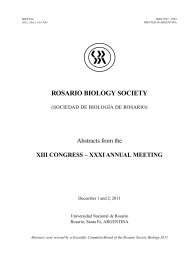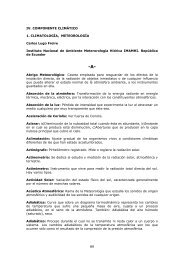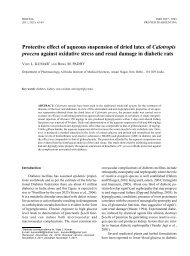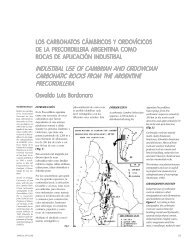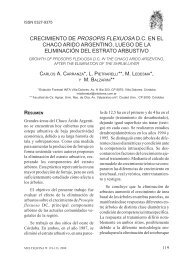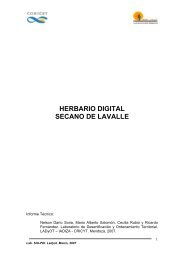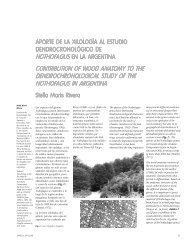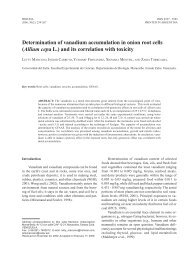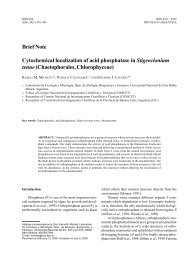XXII Annual Scientific Meeting, Tucuman Biology Society ...
XXII Annual Scientific Meeting, Tucuman Biology Society ...
XXII Annual Scientific Meeting, Tucuman Biology Society ...
You also want an ePaper? Increase the reach of your titles
YUMPU automatically turns print PDFs into web optimized ePapers that Google loves.
198 ABSTRACTS<br />
129.<br />
CONTENT OF POLYPHENOLS IN LEMON JUICE FROM<br />
TUCUMAN<br />
Alvarez A, Jorrat S, Genta M.<br />
INTA EEA Famaillá, Ruta 301 km 32, Tucumán y Cát. de Qca.<br />
Analítica II, FaCET, UNT, Avda. Roca 1800. Tucumán.<br />
The content of total polyphenols is a parameter that allows to characterize<br />
the lemon juice from a certain geographical region and<br />
also to contribute information about a nutritional component that<br />
has possitive effects on the human health, since there has been demonstrated<br />
that the polyphenols reduce the risk of cardiovascular<br />
diseases. The objective of the present work was to evaluate the<br />
content of total polyphenols in lemon juice from Tucumán as a<br />
parameter of characterization and to compare it with other drinks<br />
reported in the bibliography as source of polyphenols, such as red<br />
wine and black tea. There were analyzed 47 samples of concentrated<br />
juice of lemon, representative each one of a batch of 10000<br />
liters of concentrated juice. The concentrated juice was diluted up<br />
to reaching the brix corresponding to a natural juice. The determination<br />
of total polyphenols was realized for Folin Ciocalteu’s<br />
method. The average content of total polyphenols was of (933.0 ±<br />
11.3) mg of Gallic acid equivalent for liter. This concentration is<br />
four times higher than the content of plyphenols of red wine (210<br />
mg/L) and black tea (235 mg/L). In conclusion, the lemon juice<br />
from <strong>Tucuman</strong> has a high content of total polyphenols.<br />
130.<br />
RADIOGRAPHIC STUDY OF MIXED DENTITION<br />
ACCORDING TO NUTRITIONAL STATUS<br />
Romero S 1 , Páez R 2 , Lencina V 3 , Lorca A 1 , Delgado AM 2,4 .<br />
1 Sala de Rayos, 2 Odont. Preventiva, 4 Farmacología y Terap. Fac.<br />
de Odontología. 3 Bioestadística, Fac. de Medicina. UNT.<br />
Objective: To determine radiographically on size, shape, number<br />
and mineralization stage of primary and permanent dentition on<br />
normal and malnourished children from S.M. de Tucumán Material<br />
and Metods: Two groups were formed: one uetrofic children<br />
and other malnourished. Retroalveoar radioghaph from left lower<br />
arch were taken. Dental age was determine by the dental developmental<br />
stage adapted by Haavikko. Results: Sample was constituted<br />
by 34 malnourished and 55 normal. Proportion of children<br />
with studied alterations, didn‘t vary according to nutritional status.<br />
(P>0.15 in all pathologies). It was detected though, that 1º permanent<br />
molar eruption grade differ significativelly according to child<br />
nutritional status (P=0.023), non erupted 1º molar proportion is<br />
higher in malnourished children and root calcification degree differ<br />
according to nutrition status (P=0.01). Proportion of children<br />
with deficient radicular development degree (< a 1/3) is higher<br />
between malnourished than normal. Conclusion: studied pathologies<br />
don‘t differ according to nutritional state. Among malnourished<br />
1º molar eruption degree and radicular development is lower<br />
than that in normal children.<br />
BIOCELL 30(1), 2006<br />
131.<br />
ISOLATION OF A PROTEIN DERIVED FROM SPERM<br />
EXTRACTS CAPABLE OF INDUCING THE ACTIVATION<br />
OF Bufo arenarum OOCYTES MATURED IN VITRO<br />
Bonilla F, Ajmat MT, Sánchez Toranzo G, Zelarayán L, Oterino J,<br />
Bühler MI.<br />
Instituto de Biología. UNT - INSIBIO. Chacabuco 461. (4000)<br />
Tucumán. E-mail: mbuhler@unt.edu.ar / mbuhler@unt.edu.ar<br />
In the fertilization of most animals, egg activation is accompanied<br />
by an increase in cytoplasmatic Ca++; however, the mechanism<br />
through which the fertilizing sperm induce this phenomenon is still<br />
controversial. This work aims at: a) the isolation of the active fraction<br />
of the sperm extract; b) the analysis of its effect on egg activation<br />
under different experimental conditions.<br />
The sperm extract was subjected to gel filtration chromatography<br />
and the fraction with biological activity was dialyzed against 1%<br />
NaCl; then polyacrylamide-SDS electrophoresis was carried out.<br />
The experiments were performed with in vitro denuded Bufo<br />
arenarum oocytes. The activation parameters considered were the<br />
disappearance of the white spot, the elevation of the vitelline envelope<br />
and the cortical granules exocitosis.<br />
The results indicate that in the fraction with biological activity of<br />
the sperm extract there is a protein of approximately 30 Kda. This<br />
protein is capable of activating the eggs in a dose-dependent manner<br />
when it is added to the culture medium; however, it has no<br />
effect when microinjected into the egg cytoplasm. These results<br />
indicate that the protein isolated from the sperm extract would interact<br />
with receptors on the oocyte membrane capable of activating<br />
the signaling pathways that lead to activation.<br />
132.<br />
MICROBIOLOGICAL MONITORING OF SUGARCANE<br />
JUICE AT DIFFERENT STAGES OF THE CLARIFICATION<br />
PROCESS<br />
Anduni G, Gusils C, Ruiz M, Cárdenas G.<br />
EEAOC, Av. Williams Cross 3150. Tucumán, Argentina. E-mail:<br />
guilleanduni@eeaoc.org.ar<br />
Cane sugar manufacturing process begins with the reception of<br />
sugarcane in the sugar mill, where it is crushed to extract its sugared<br />
juice, which is subsequently filtered, sulfated, decanted, limed<br />
and heated. The juice is then decanted in clarifiers to obtain clarified<br />
juice. During all these stages, the microorganisms existing in<br />
sugar cane play an important role in relation to the efficiency and<br />
quality of the final product.<br />
As a first step to control microbiologic quality, the microbial content<br />
of sugarcane juices obtained in Tucumán sugar industry, was<br />
analyzed. The microbiological methodology was performed according<br />
to ICUMSA official protocols.<br />
When analyzing the values obtained, it could be observed that in<br />
the case of first expressed juice and mixed juice, most of sugar<br />
mills exhibited very similar count of bacteria, fungi, yeast or<br />
polysaccharide-producing microorganisms.<br />
In clarified juices, values obtained were low, and fungus and yeast<br />
were absent.<br />
From the results mentioned above, it can be stated that it is important<br />
to control different aspects of the clarification process in order<br />
to avoid the appearance of undesired microorganisms affecting yield<br />
efficiency.



